Influences of West Pacific Sea Surface Temperature on Covarying Eurasian Droughts Since the Little Ice Age
Abstract
1. Introduction
2. Data and Methods
2.1. Tree-Ring Data
2.2. Meteorological Data
2.3. Methods
3. Results and Discussion
3.1. Western Pacific Warm Pool Sea Surface Temperature and Precipitation in Eurasia in Instrumental Periods
3.2. Oceanic and Atmospheric Processes Linking Western Pacific Warm Pool Sea Surface Temperature and Precipitation in Eurasia
4. Relationship with Western Pacific Warm Pool Sea Surface Temperature since the Little Ice Age
4.1. Central Asia–Mongolia Dipole Mode
4.2. Impact Factors
5. Conclusions
- (1)
- In Asia, there is a CAMO dipole in which precipitation is regulated by WPSST. The precipitation increases (decreases) in Central Asia (Mongolia) when WPSST rises. In Europe, a NESE dipole with a positive (negative) correlation between WPSST was found, and precipitation increases (decreases) in Northern (Southern) Europe when WPSST rises.
- (2)
- The impact of WPSST anomalies on precipitation changes in Eurasia is largely regulated by ENSO. When there is an ENSO positive (negative) phase event, the corresponding WPSST decreases (increases), and the decreases (increases) of precipitation in Central Asia and Northern Europe and the increases (decreases) in precipitation in Mongolia and Southern Europe are more obvious. Both CAMO and NESE dipole strengths increase.
- (3)
- The impact of WPSST on precipitation in Europe and Asia is mainly generated by atmospheric circulation. When WPSST is increased, Central Asia is mainly an east wind anomaly. The warm and humid airflow bring abundant water vapor, and the precipitation in East Asia increases. Mongolia has dry–cold west wind with reduced precipitation. The difference in precipitation between Central Asia and Mongolia is strengthened and the CAMO dipole is enhanced. At the same time, when WPSST rises, the wind field over the European continent is from southwest to northeast. The humidity transmission in Northern (Southern) Europe is enhanced (weakened). Northern (Southern) Europe has an obvious (reverse) cyclonic circulation. The moisture in Northern Europe is above average, while Southern Europe is drier, and the NESE dipole is enhanced.
- (4)
- The CAMO dipole of 1280–1990 was reconstructed using the tree-ring chronology. This dipole has a significant correlation on the interdecadal scale. The CAMO dipole has a positive correlation with solar radiation and the temperature in the Northern Hemisphere since the LIA. When the solar radiation is enhanced and the temperature in the Northern Hemisphere is increased, the WPSST is increased and the dipole is enhanced. The CAMO dipole is negatively correlated with PDO, and the periodicity of CAMO on the interdecadal scale is consistent with the PDO period. The intensity of the CAMO dipole is enhanced when the PDO is weakened. During the contemporary warm period since the industrial age, the CAMO dipole was still extremely strong during periods when the increase in solar radiation is not obvious and the PDO is not significantly weakened, which may be mainly due to the sharp increases in temperature caused by industrial activities.
Author Contributions
Funding
Acknowledgments
Conflicts of Interest
References
- Barros, V.; Stocker, T.F. Managing the risks of extreme events and disasters to advance climate change adaptation: Special report of the Intergovernmental Panel on Climate Change. J. Clin. Endocrinol. Metab. 2012, 18, 586–599. [Google Scholar]
- Zhang, W.; Wang, L.; Xiang, B.; Qi, L.; He, J. Impacts of two types of La Niña on the NAO during boreal winter. Clim. Dyn. 2015, 44, 1351–1366. [Google Scholar] [CrossRef]
- Dinezio, P.N.; Tierney, J.E. The effect of sea level on glacial Indo-Pacific climate. Nat. Geosci. 2013, 6, 485–491. [Google Scholar] [CrossRef]
- Zanardo, S.; Nicotina, L.; Hilberts, A.G.J.; Jewson, S.P. Modulation of economic losses from European floods by the North Atlantic Oscillation. Geophys. Res. Lett. 2019, 46, 2563–2572. [Google Scholar] [CrossRef]
- Nitta, T. Convective activities in the tropical western Pacific and their impact on the Northern Hemisphere summer circulation. J. Meteorol. Soc. Jpn. Ser. II 1987, 65, 373–390. [Google Scholar] [CrossRef]
- Chen, G.; Fang, C.; Zhang, C.; Chen, Y. Observing the coupling effect between warm pool and “rain pool” in the Pacific Ocean. Remote Sens. Environ. 2004, 91, 153–159. [Google Scholar] [CrossRef]
- DiNezio, P.N.; Clement, A.; Vecchi, G.A.; Soden, B.; Broccoli, A.J.; Otto-Bliesner, B.L.; Braconnot, P. The response of the Walker circulation to Last Glacial Maximum forcing: Implications for detection in proxies. Paleoceanogr. Paleoclimatology 2011, 26. [Google Scholar] [CrossRef]
- Mohtadi, M.; Prange, M.; Oppo, D.W.; Pol-Holz, R.D.; Ute, M.; Zhang, X.; Steinke, S.; Luckge, A. North Atlantic forcing of tropical Indian Ocean climate. Nature 2014, 509, 76–80. [Google Scholar] [CrossRef]
- Hoerling, M.P. Tropical Origins for Recent North Atlantic Climate Change. Science 2001, 292, 90–92. [Google Scholar] [CrossRef]
- Huang, R.; Sun, F. Interannual variation of the summer teleconnection pattern over the northern hemisphere and its numerical simulation. Chin. J. Atmos. Sci. 1992, 16, 52–61. (In Chinese) [Google Scholar]
- Min, J.Z.; Li, C.; Wu, P. A Study of the relationship between summer tropical convection over the western pacific and the rainfall in the middle-lower reaches of the Yangtze River. Chin. J. Atmos. Sci. 2005, 29, 947–954. (In Chinese) [Google Scholar]
- Kucharski, F.; Molteni, F.; Bracco, A. Decadal interactions between the western tropical Pacific and the North Atlantic Oscillation. Clim. Dyn. 2006, 26, 79–91. [Google Scholar] [CrossRef]
- Hurrell, J.W.; Hoerling, M.P.; Phillips, A.S.; Xu, T. Twentieth century North Atlantic climate change. Part I: Assessing determinism. Clim. Dyn. 2004, 23, 371–389. [Google Scholar] [CrossRef]
- Hoerling, M.P.; Hurrell, J.W.; Xu, T.; Bates, G.T.; Phillips, A.S. Twentieth century North Atlantic climate change. Part II: Understanding the effect of Indian Ocean warming. Clim. Dyn. 2004, 23, 391–405. [Google Scholar] [CrossRef]
- Allen, S.K.; Plattner, G.K.; Nauels, A.; Xia, Y.; Stocker, T.F. Climate Change 2013: The Physical Science Basis. An overview of the Working Group 1 contribution to the Fifth Assessment Report of the Intergovernmental Panel on Climate Change (IPCC); EGU General Assembly: Lund, Sweden, 2014; Volume 16. [Google Scholar]
- Hughes; Malcolm, K. Dendroclimatology: Progress and Prospects; Thomas, W.S., Diaz, H.F., Eds.; Science & Business Media: Berlin/Heidelberg, Germany, 2010; Volume 11. [Google Scholar]
- Yang, B.; Qin, C.; Wang, J.; He, M.; Melvin, T.M.; Osborn, T.J.; Briffa, K.R. A 3,500-year tree-ring record of annual precipitation on the northeastern Tibetan Plateau. Proc. Natl. Acad. Sci. USA 2014, 111, 2903–2908. [Google Scholar] [CrossRef] [PubMed]
- Gou, X.; Deng, Y.; Gao, L.; Chen, F.; Cook, E.; Yang, M.; Zhang, F. Millennium tree-ring reconstruction of drought variability in the eastern Qilian Mountains, northwest China. Clim. Dyn. 2015, 45, 1761–1770. [Google Scholar] [CrossRef]
- Kaiser, K.F.; Friedrich, M.; Miramont, C.; Kromer, B.; Sgier, M.; Schaub, M.; Boeren, I.; Remmele, S.; Talamo, S.; Guibal, F.; et al. Challenging process to make the Lateglacial tree-ring chronologies from Europe absolute—An inventory. Quat. Sci. Rev. 2012, 36, 78–90. [Google Scholar] [CrossRef]
- Cook, E.R. A Time Series Analysis Approach to Tree Ring Standardization. Ph.D. Thesis, The University of Arizona, Tucson, AZ, USA, 1985. [Google Scholar]
- Kirdyanov, A.V.; Treydte, K.S.; Nikolaev, A.; Helle, G.; Schleser, G.H. Climate signals in tree-ring width, density and δ13C from larches in Eastern Siberia (Russia). Chem. Geol. 2008, 252, 31–41. [Google Scholar] [CrossRef]
- Cook, E.R.; Krusic, P.J.; Anchukaitis, K.J.; Buckley, B.M.; Nakatsuka, T.; Sano, M. PAGES Asia2k Members. Tree-ring reconstructed summer temperature anomalies for temperate East Asia since 800 C.E. Clim. Dyn. 2013, 41, 2957–2972. [Google Scholar] [CrossRef]
- Hirahara, S.; Ishii, M.; Fukuda, Y. Centennial-scale sea surface temperature analysis and its uncertainty. J. Clim. 2014, 27, 57–75. [Google Scholar] [CrossRef]
- Huang, R.; Sun, F. Impacts of the Thermal State and the Convective Activities in the Tropical Western Warm Pool on the Summer Climate Anomalies in East Asia. Chin. J. Atmos. Sci. 1994, 18, 141–151. (In Chinese) [Google Scholar]
- Jin, Z.; Chen, W. Study on the influence of sea surface water warming anomaly on the East Asian summer monsoon in the western Pacific warm pool area. Atmos. Sci. 2002, 26, 57–68. (In Chinese) [Google Scholar]
- Kalnay, E.; Kanamitsu, M.; Kistler, R.; Collins, W.; Deaven, D.; Gandin, L.; Iredell, M.; Saha, S.; White, G.; Woollen, J.; et al. The NCEP-NCAR 40-year reanalysis project. Bull. Am. Meteor. Soc. 1996, 77, 437–472. [Google Scholar] [CrossRef]
- MacDonald, G.M.; Case, R.A. Variations in the Pacific Decadal Oscillation over the past millennium. Geophys. Res. Lett. 2005, 32. [Google Scholar] [CrossRef]
- Bard, E.; Raisbeck, G.; Yiou, F.; Jouzel, J. Solar irradiance during the last 1200 years based on cosmogenic nuclides. Tellus B 2000, 52, 985–992. [Google Scholar] [CrossRef]
- Mann, M.E.; Zhang, Z.; Rutherford, S.; Bradley, R.S.; Hughes, M.K.; Shindell, D.; Ammann, C.; Faluvegi, G. Global signatures and dynamical origins of the Little Ice Age and Medieval Climate Anomaly. Science 2009, 326, 1256–1260. [Google Scholar] [CrossRef] [PubMed]
- Qian, W.; Hu, Q.; Zhu, Y.; Lee, D.K. Centennial-scale dry-wet variations in East Asia. Clim. Dyn. 2003, 21, 77–89. [Google Scholar] [CrossRef]
- Peng, Z.; Wang, Q.J.; Bennett, J.C.; Pokhrel, P.; Wang, Z. Seasonal precipitation forecasts over China using monthly large-scale oceanic-atmospheric indices. J. Hydrol. 2014, 519, 792–802. [Google Scholar] [CrossRef]
- Sutton, R.T.; Hodson, D.L.R. Atlantic Ocean forcing of North American and European summer climate. Science 2005, 309, 115–118. [Google Scholar] [CrossRef]
- Lupo, A.R.; Mokhov, I.I.; Chendev, Y.G.; Lebedeva, M.G.; Akperov, M.; Hubbart, J.A. Studying summer season drought in western Russia. Adv. Meteorol. 2014, 2014. [Google Scholar] [CrossRef]
- Folland, C.K.; Knight, J.; Linderholm, H.W.; Fereday, D.; Ineson, S.; Hurrell, J.W. The summer North Atlantic Oscillation: Past, present, and future. J. Clim. 2009, 22, 1082–1103. [Google Scholar] [CrossRef]
- Liu, Y.; Cobb, K.M.; Song, H.; Li, Q.; Li, C.Y.; Nakatsuka, T.; Linderholm, H.W. Recent enhancement of central Pacific El Nino variability relative to last eight centuries. Nat. Commun. 2017, 8, 15386. [Google Scholar] [CrossRef] [PubMed]
- Yan, H.; Wei, W.; Soon, W.; An, Z.; Zhou, W.; Liu, Z.; Wang, Y.; Carter, R.M. Dynamics of the intertropical convergence zone over the western Pacific during the Little Ice Age. Nat. Geosci. 2015, 8, 315–320. [Google Scholar] [CrossRef]
- Liu, J.; Wang, B.; Cane, M.A.; Yim, S.; Lee, J. Divergent global precipitation changes induced by natural versus anthropogenic forcing. Nature 2013, 493, 656–659. [Google Scholar] [CrossRef] [PubMed]
- Allan, R.; Lindesay, J.; Parker, D. El Niño Southern Oscillation and Climatic Variability. N. Z. Geogr. 1998, 54, 64–65. [Google Scholar]
- Fang, K.; Cook, E.; Guo, Z.; Chen, D.; Ou, T.; Zhao, Y. Synchronous multi-decadal climate variability of the whole Pacific areas revealed in tree rings since 1567. Environ. Res. Lett. 2018, 13, 024016. [Google Scholar] [CrossRef]
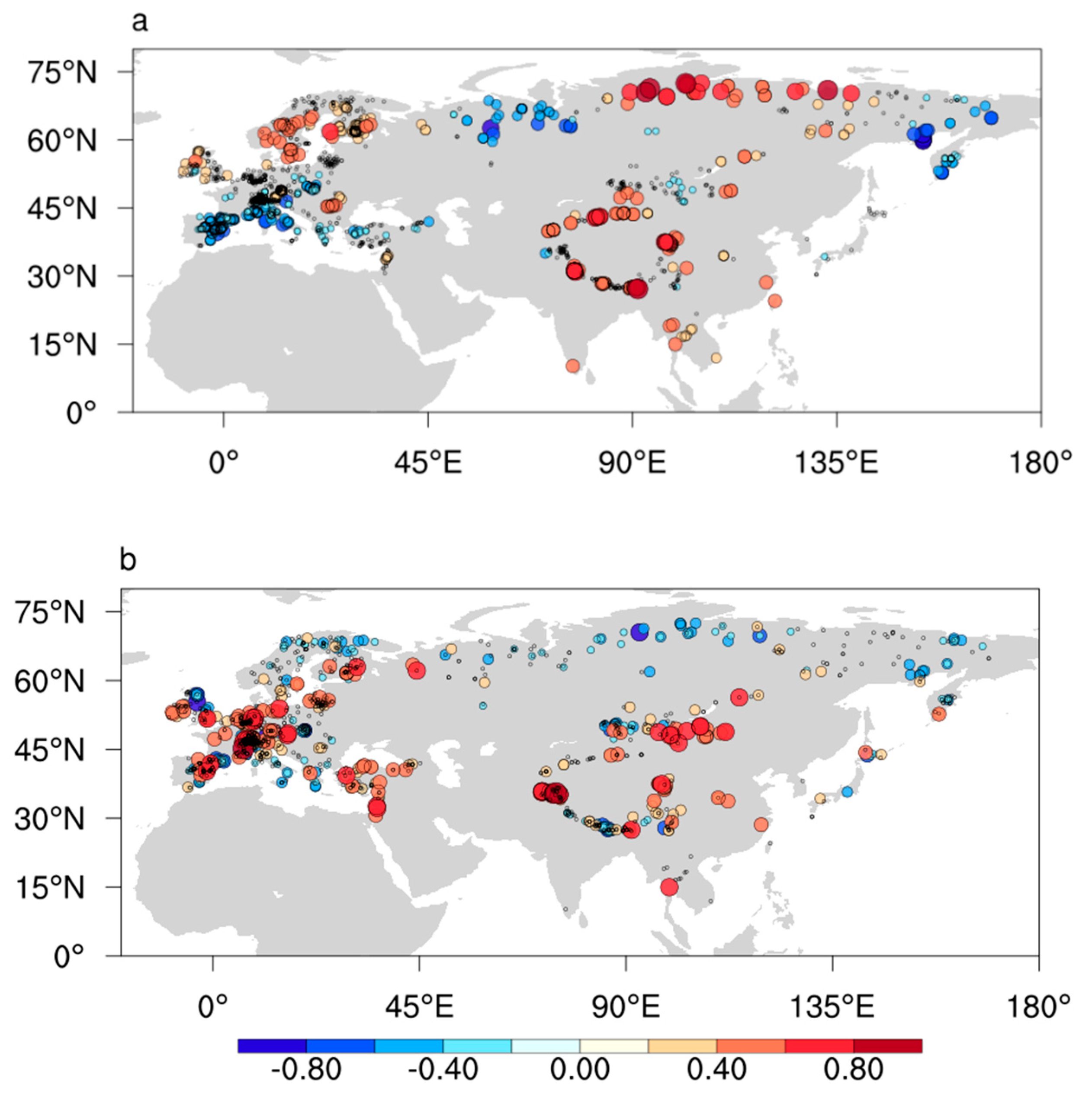
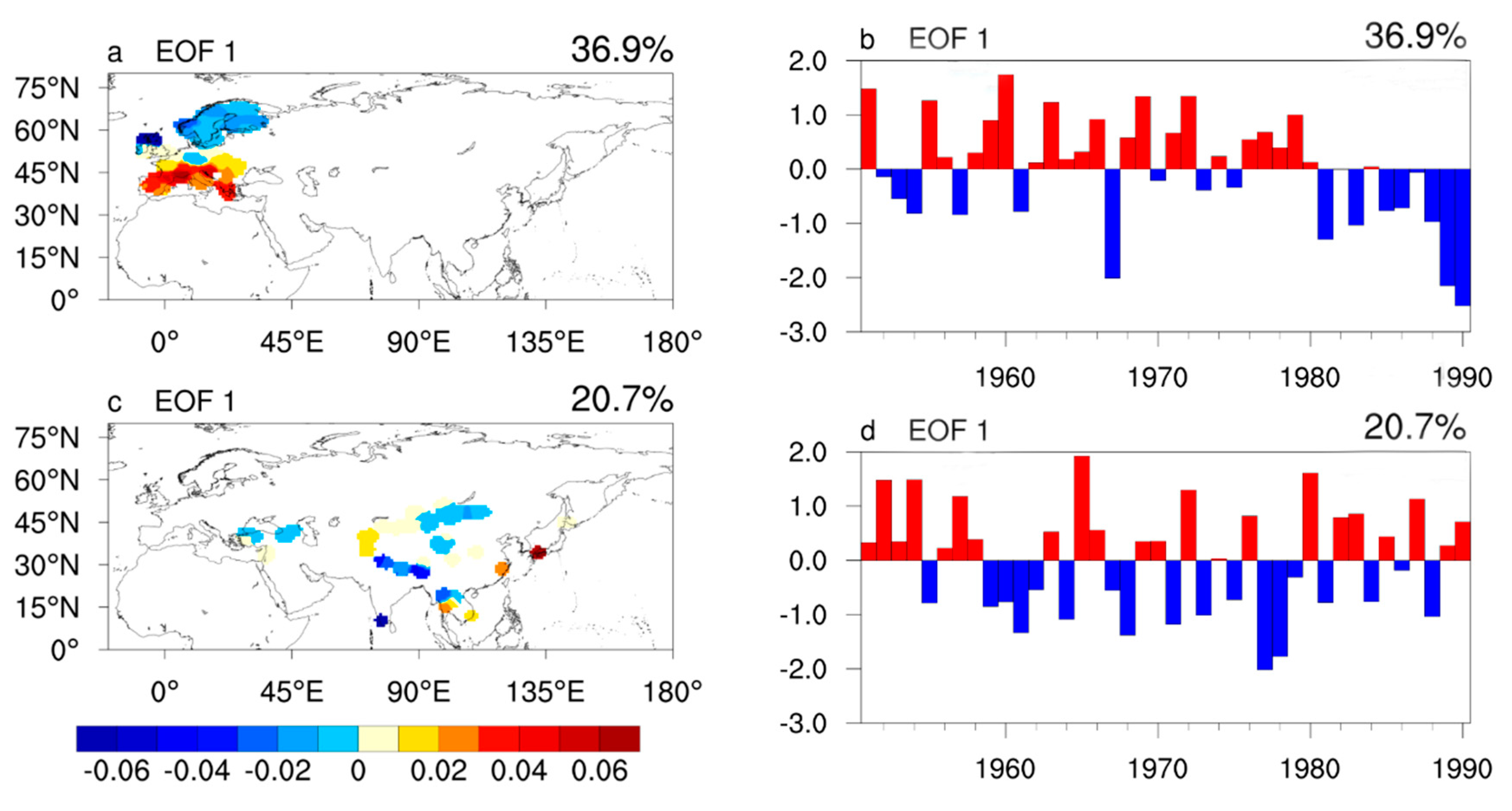


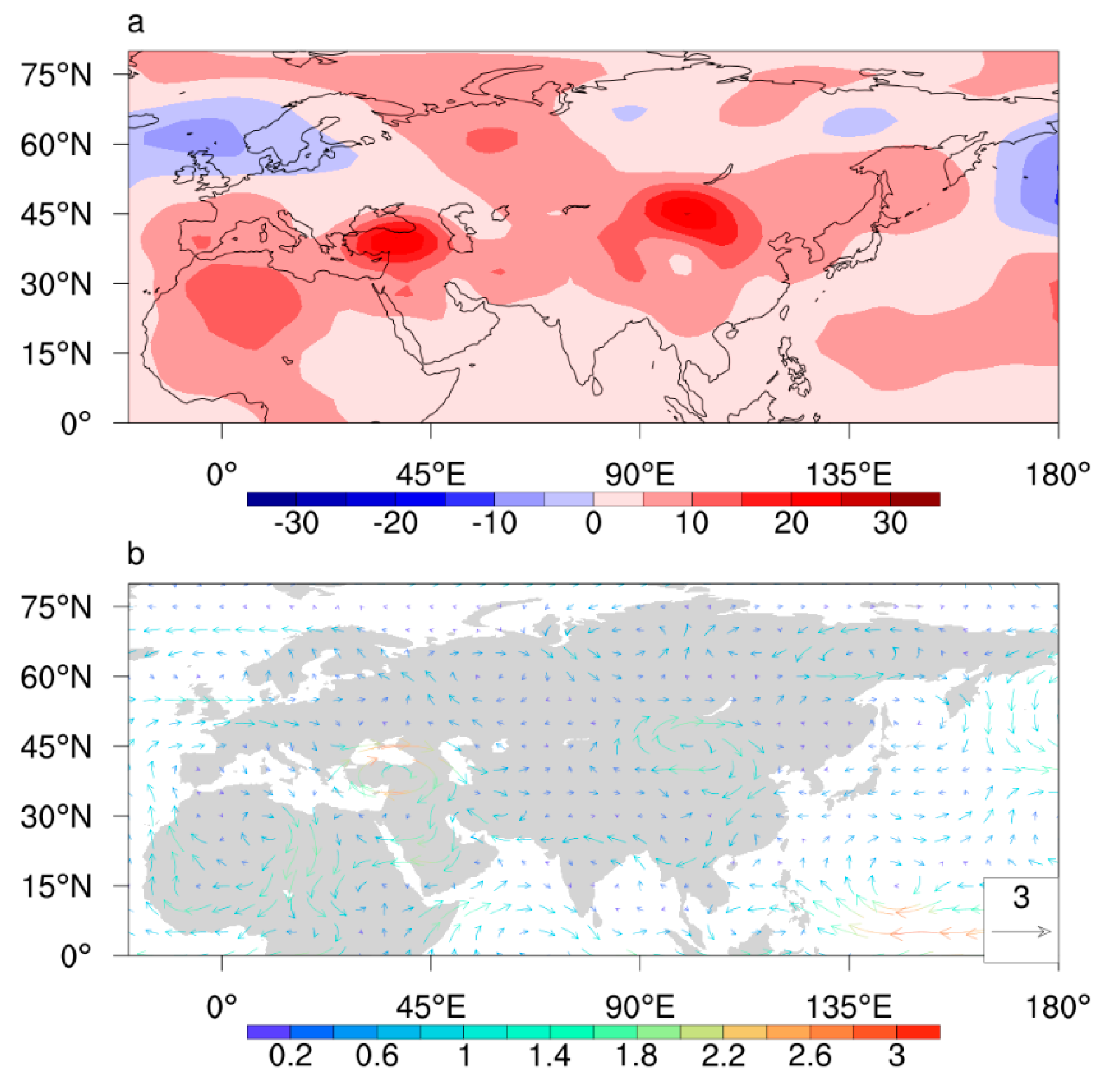
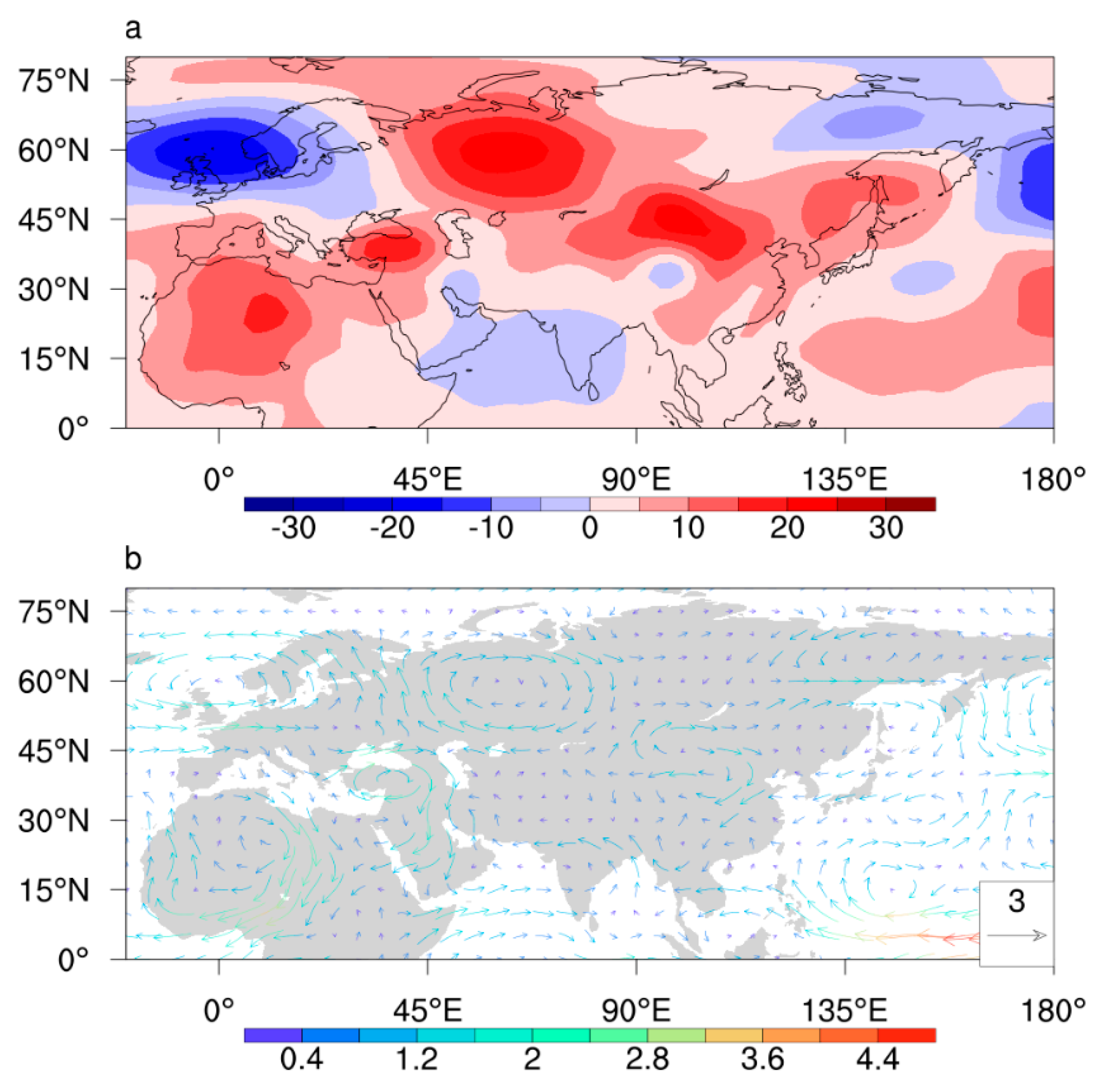
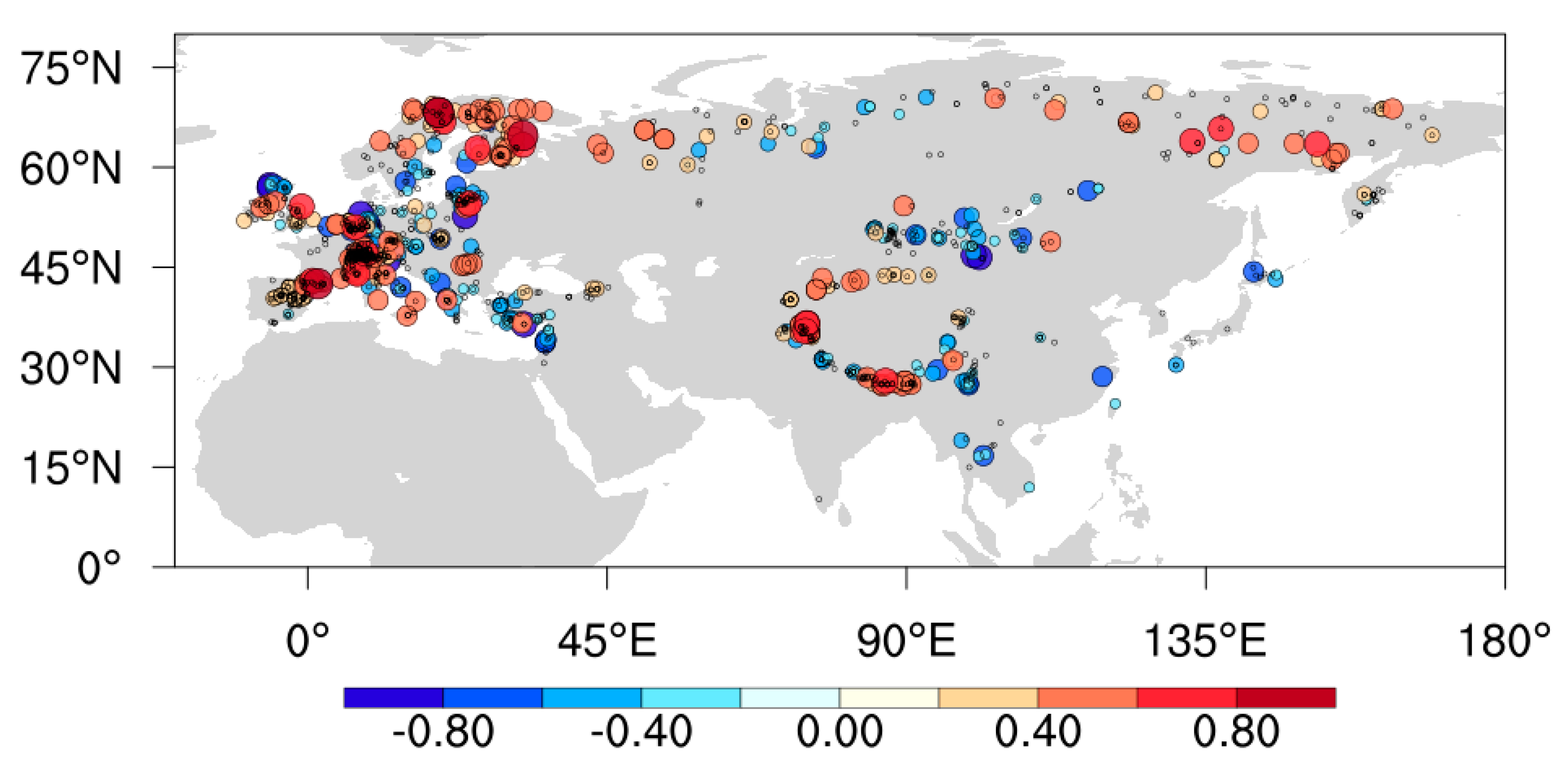

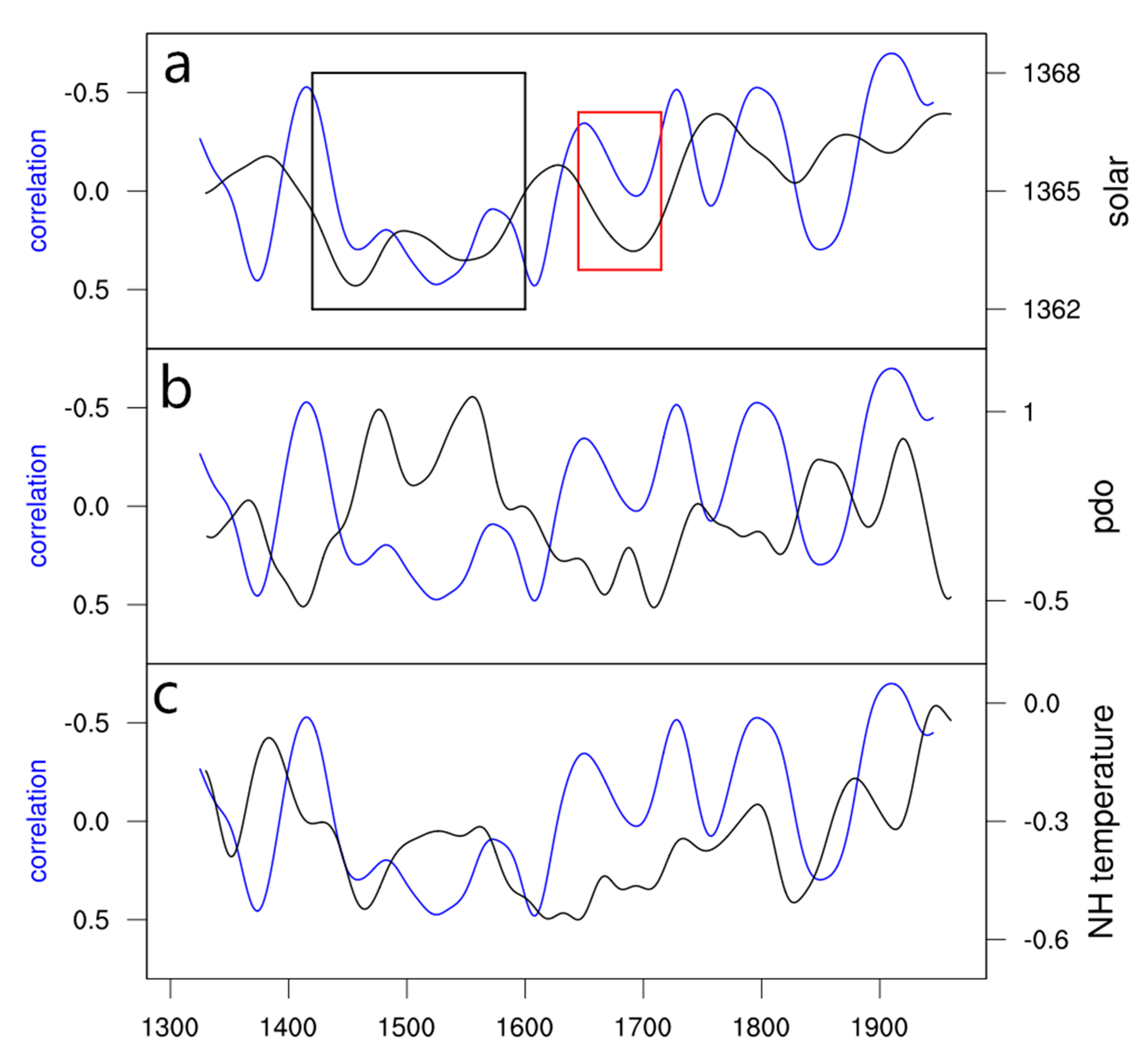
© 2020 by the authors. Licensee MDPI, Basel, Switzerland. This article is an open access article distributed under the terms and conditions of the Creative Commons Attribution (CC BY) license (http://creativecommons.org/licenses/by/4.0/).
Share and Cite
Li, H.; Fang, K.; Du, J.; Zhou, F.; Dong, Z.; Zhang, P.; Huang, G. Influences of West Pacific Sea Surface Temperature on Covarying Eurasian Droughts Since the Little Ice Age. Quaternary 2020, 3, 16. https://doi.org/10.3390/quat3020016
Li H, Fang K, Du J, Zhou F, Dong Z, Zhang P, Huang G. Influences of West Pacific Sea Surface Temperature on Covarying Eurasian Droughts Since the Little Ice Age. Quaternary. 2020; 3(2):16. https://doi.org/10.3390/quat3020016
Chicago/Turabian StyleLi, Huanhuan, Keyan Fang, Jianhua Du, Feifei Zhou, Zhipeng Dong, Peng Zhang, and Gang Huang. 2020. "Influences of West Pacific Sea Surface Temperature on Covarying Eurasian Droughts Since the Little Ice Age" Quaternary 3, no. 2: 16. https://doi.org/10.3390/quat3020016
APA StyleLi, H., Fang, K., Du, J., Zhou, F., Dong, Z., Zhang, P., & Huang, G. (2020). Influences of West Pacific Sea Surface Temperature on Covarying Eurasian Droughts Since the Little Ice Age. Quaternary, 3(2), 16. https://doi.org/10.3390/quat3020016





